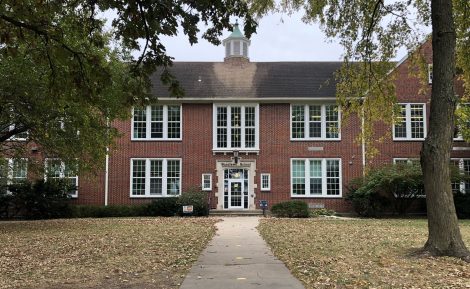Steady enrollment in Lawrence school district means better budget picture for next school year, but multiple factors still at play

photo by: Journal-World
Lawrence Public Schools district offices pictured in April 2021.
The Lawrence school board will soon get its first look at some of the numbers that will go into determining what next school year’s budget looks like. And while multiple variables are still undetermined, steady enrollment means the district is not likely to face the shortfalls related to enrollment declines that it did going into this school year.
As part of its meeting Monday, the board will review the 2022-2023 budget, recent enrollment counts and potential outcomes for the 2023-2024 budget based on those counts. As the Journal-World reported in September, preliminary numbers indicate enrollment between last school year and this school year has remained steady, and Monday’s presentation will go into other factors — such as the number of “at-risk” students enrolled in the district this year — that will affect how much state funding the district will receive next year.
A key number in the calculation is the district’s full-time equivalent student enrollment, or FTE, which is the main component used to determine how much funding the district receives as part of the state’s K-12 education funding formula. The annual count in September indicates the district had one fewer student than last year and an FTE of 9,977.3, which is 8.3 FTE lower than last year. However, there are various other characteristics of the district’s student population that affect how much additional funding the district will receive on top of the base amount.
For example, because of a significant increase in the number of students qualifying for free meals — 3,566 students representing 35% of all students enrolled — figures indicate the district will receive about $2.98 million more in “at-risk” funding associated with that funding component, an amount that could increase once the Consumer Price Index is used in April to adjust state aid calculations. However, other funding components, known as weightings, went down and will offset that number.
In addition to “at-risk” students, the funding formula has weightings for at-risk preschool students, students living in high-density areas, instruction hours for bilingual students, career and technical education instruction hours, and the number of virtual students. The number of virtual students is one of the weightings that will go down.
According to the presentation, the preliminary enrollment numbers collected in September found the district has 692.3 FTE virtual students, a decrease of approximately 190 FTE students from last year. Presentation materials indicate the district receives $5,600 per FTE for virtual students, which would mean a drop of 190 FTE could result in a decrease of around $1 million in funding at the current funding levels. The presentation also included amounts for the other weightings, but did not include the amount received last school year for comparison.
Another weighting that could potentially increase is the district’s funding for at-risk preschoolers. The district began phasing in a Montessori program at New York Elementary this school year that is open to 3- and 4-year-olds and prioritizes at-risk children, and is in addition to its existing early childhood center at the former Kennedy Elementary School building. The presentation indicates unaudited enrollment for 2022-2023 counted 52 preschool-aged at-risk students, which under current state funding would provide the district $125,996 for that weighting. To qualify as “at-risk,” preschool students must qualify for free meals or have other risk factors, such as coming from a single-parent family.
All the enrollment figures are preliminary and are subject to change as those numbers are audited. District spokesperson Julie Boyle said the overall FTE will likely go down because the preliminary enrollment numbers are pulled from the district’s student information system, and the auditor compares that number to actual attendance records.
The Journal-World asked district finance director Cynde Frick when the district will have the projected change in funding for the 2023-2024 year, as it relates to the FTE and the various weightings included in the presentation. Frick responded that the 2023-2024 budget will be discussed on Monday and that funding will be determined by the state Legislature in the spring.
The presentation notes various legislative decisions that could affect funding components. Those include whether the state will indeed adjust funding amounts based on the Consumer Price Index as required by court decisions (the Kansas State Department of Education thinks the state will); whether the weighting for students who live in high-density areas will be renewed; and whether the state will increase funding for special education. As part of Monday’s meeting, the board will also discuss the district’s remaining federal pandemic-related funding.
The school district made $6.41 million in budget cuts last year to account for a $4.34-million shortfall related to enrollment declines and other enrollment-based funding, and to allocate funding for staff raises and the district’s reserve funds. Though the district does not appear to be facing such an enrollment-related shortfall for next school year, the school board has expressed a desire to allocate more money toward staff raises, increasing costs, and reserves.
The Lawrence school board will convene at 6 p.m. Monday at district offices, 110 McDonald Drive.







